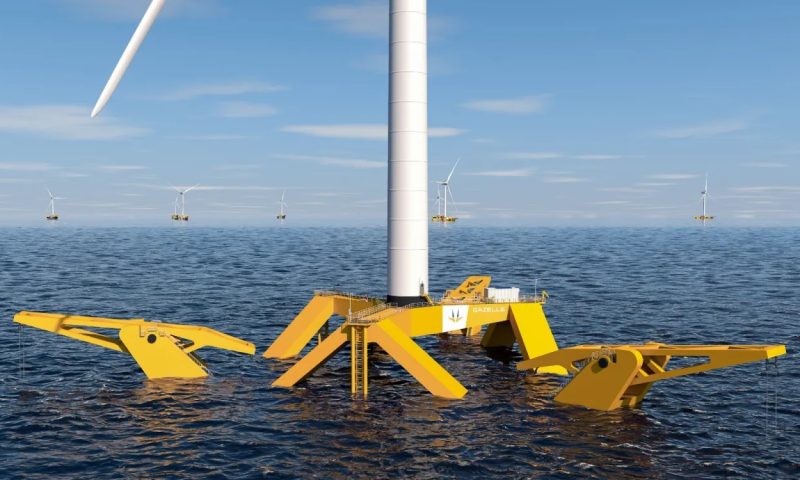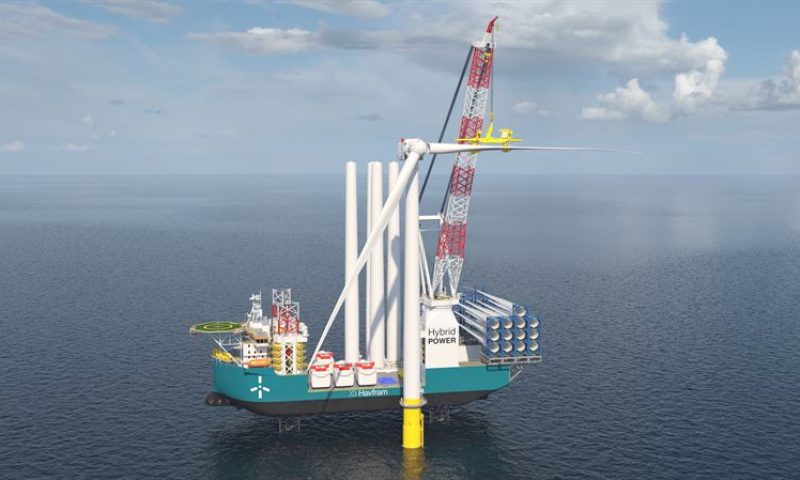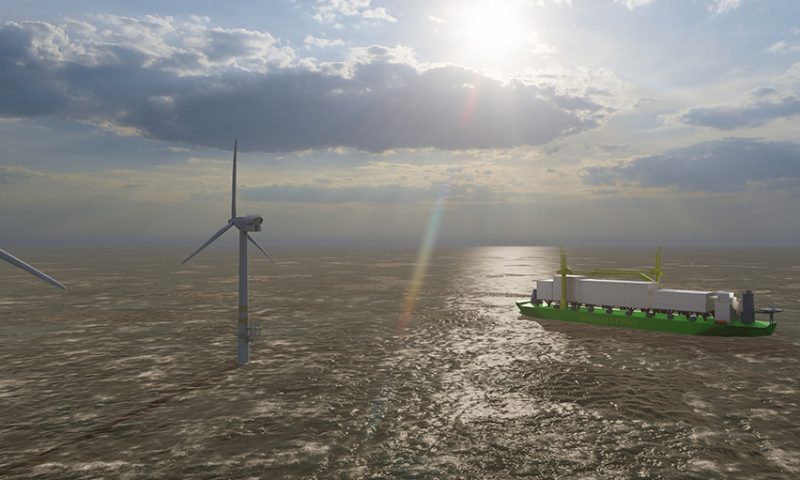
Van Oord’s new WTIV will be Methanol-Electric
Van Oord’s new Wind Turbine Installation Vessel (WTIV) Boreas will be powered by five Wärtsilä 32 dual-fuel methanol generators. It is the first time Wärtsilä supplies methanol engines for a newbuild project. Schiedam based Huisman will construct a Leg Encircling Crane (LEC) with a lifting capacity of more than 3000 tonnes for the vessel. It is the crane builder’s largest of this type to date.
The Chinese Yantai CIMC Raffles Shipyard will build Van Oord’s 175-metre-long and over 60-metre-wide lift installation vessel.
Danish Architects
The Danish naval architects of Knud E. Hansen designed the self-elevating installation vessel, which is optimized for the installation of a new generation of 20 MW wind turbines, with a diameter of 260 metres.
The 130-metre-long blades of these turbines will reach 300 meters above the waterline.
Self-Elevating Installation
The self-elevating installation vessel gets four 126-metre-long legs. They can lift the ship in water depths of up to 70 meters. Huisman Schiedam will design and build the giant Leg Encircling Crane (LEC) needed to install the giant wind turbines.
The Boreas will have 88 per cent more deck space and eighty per cent more lifting capacity than the installation vessel Aeolus, which was built for Van Oord in 2014. The Aeolus can operate in water depths of up to 45 meters.
Methanol-Electric
Marjolein Boer
The five medium-speed dual-fuel methanol engines in the “methanol-electric” Boreas will have different power ratings. ‘We have opted for different versions with different numbers of cylinders,’ says Van Oord spokeswoman Marjolein Boer.
Wärtsilä 32DF
The Wärtsilä 32DF methanol engines are available in different versions; from six to sixteen cylinders, with different power ratings; from 3480 to 9280 kW at 750 rpm.
Serge van der Veere
‘The methanol is injected according to the diesel principle” explains spokesman Serge van der Veere of Wärtsilä.
Wärtsilä’s System
The system was first used by Wärtsilä during a refit in 2015 on the ferry Stena Germanica, built in 2002. Between 2015 and 2017, the four existing Sulzer 8ZAL 40S diesel engines of this ship were converted into dual-fuel methanol engines.
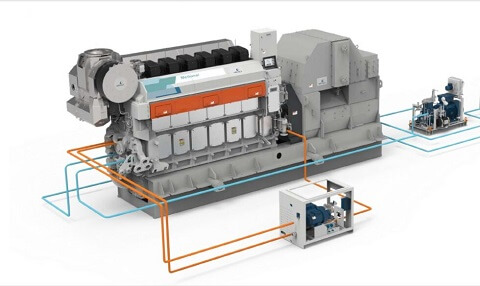
A six-cylinder Wärtsilä 32 dual-fuel methanol engine with a generator (illustration Wärtsilä)
Dual-Fuel Mode
In dual-fuel mode, they run on methanol for 95 per cent at full load and on methanol for ninety per cent at partial load. An additional diesel injection takes care of the ignition of the methanol.
Reduced Emissions
Sailing on methanol, particulate emissions are reduced by up to 95 per cent and NOX emissions by sixty per cent, according to sustainability director Erik Lewenhaupt of Stena.
New Injectors
A new injector for methanol engines, developed by Wärtsilä, played a key role in the conversion. These injectors have four separate circuits, with their own pressure pumps.
Methanol Injection
A high-pressure pump for methanol injection, a second one for diesel fuel injection, a third one with a hydraulic pump supplying hydraulic lube oil to control the timing of the injection and ensure a seal that prevents leakage of the methanol during the injection, and a special cooling circuit for the injectors.
Variable Valve Timing
The new methanol engines have variable valve timing. This makes it possible to close the intake valves earlier under heavy load, to further reduce NOX formation during combustion (Miller timing).
When the engines are running at low load conditions, the intake valves close later to optimize combustion.
NOX Emissions
Although the NOX emissions from the methanol engines are about sixty per cent lower than those of diesel engines (without after treatment), they will be equipped with selective catalytic reduction (SCR) converters to reduce the remaining NOX emissions to a minimum.
This also means that they can meet the IMO Tier III emission standards when fully sailing on marine diesel fuel.
Reduced CO2 emissions
Methanol has the lowest carbon and highest hydrogen content of any liquid fuel. Even when methanol is made from natural gas (grey methanol), the CO2 emissions are lower than those of diesel.
CO2 Neutral
When green methanol is used, the ship will sail almost CO2 neutral. Green methanol can be made from biological residues (bio-methanol) or from hydrogen and CO2 with green electricity (e-methanol).
Supportive battery pack
Van Oord plans to install a supportive lithium-ion battery pack with a capacity of 5000 kWh on the installation vessel. It will reduce the amount of generators needed at the same time during operations.
Peak Loads
The battery pack adds power to the system during peak loads and absorbs generator power when loads are low. This “peak-shaving” makes it possible to load the generators optimally. This should reduce consumption of the expensive methanol.
Boer; Batteries
‘The ship will also be able to sail on batteries alone for quite some time,’ adds Boer.
Security of supply
Van Oord expects that bunkering methanol will be possible in more and more places in the near future.
Boer
‘We assume that this market will develop further in the coming years. We are in contact with various suppliers and were approached by additional parties after Wärtsilä’s press release,’ says Boer.
Switchable Engines
When no methanol is available, the engines can switch to marine diesel oil. Clients will have influence on the fuel used during a project.
Huisman builds gigantic crane
Huisman will construct a Leg Encircling Crane (LEC) with a lifting capacity of more than 3000 tonnes. The crane will be built around the starboard rear leg of the vessel. It will look as if this leg protrudes through the crane base.
This type of crane can rotate freely around the leg.
The Huisman Leg Encircling Crane (LEC) is specifically designed to be used on a jack-up vessel. The crane is built around the jack-up leg and if required the boom can be stored around the other leg, saving valuable deck space. The LEC has a small tail swing allowing for optimal use of free deck space.
Bearing System
A slewing bearing system, developed by Huisman, enables a very accurate and reliable positioning of the crane. A smart construction makes it possible to have a relatively light boom with a great rigidity. It will be the largest LEC ever built.
David Roodenburg
In 2014, Huisman delivered the 1600-tonne LEC crane for Van Oord’s Aeolus. “With this new order, we can continue to develop this successful product with new technical solutions” says CEO David Roodenburg from Huisman.
Knud E. Hansen
The fully electrically powered crane will be delivered in 2023 and will be integrated into the vessel at the Raffles Shipyard. This is done in close collaboration with the ship’s designer, Knud E. Hansen.
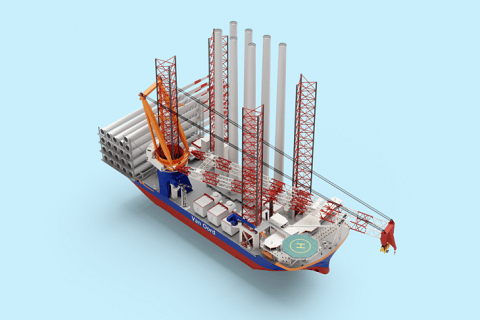
Huisman’s Leg Encircling Crane (LEC) for Van Oord’s WTIV will be the largest of this type ever built (illustration Huisman)









